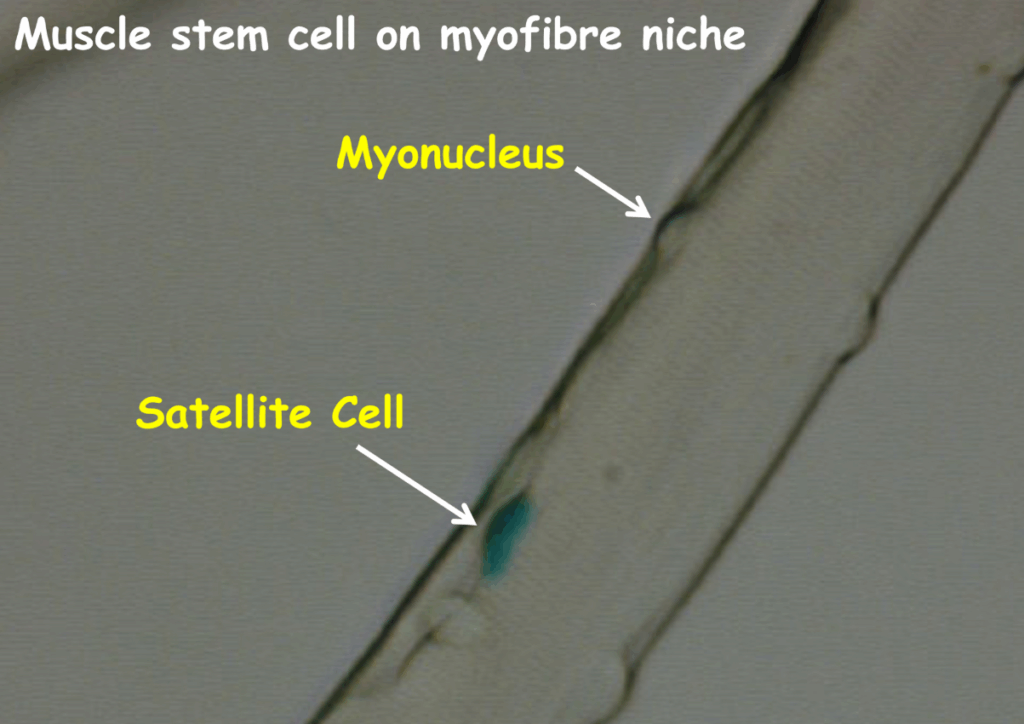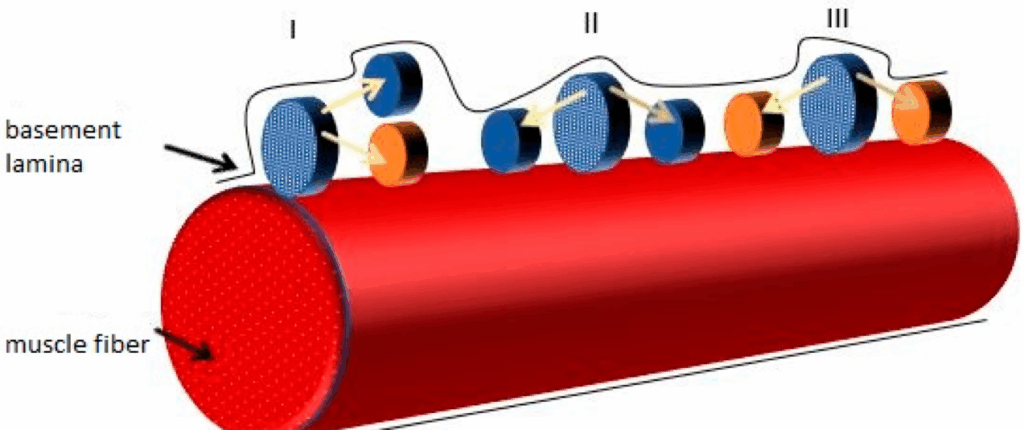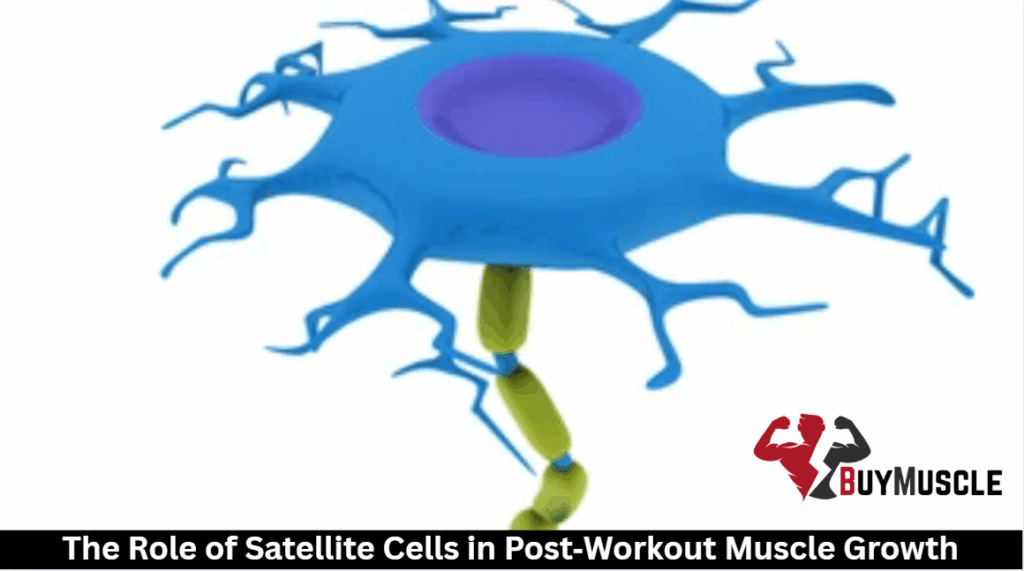When you push through those final reps at the gym, you’re not just feeling the burn. You’re activating microscopic helpers called satellite cells. These specialized stem cells sit dormant until your workout creates tiny muscle damage, triggering them into action. They’re the unsung heroes of your fitness gains, repairing damaged fibers and contributing to new muscle growth.
But how exactly do these cells transform today’s exercise into tomorrow’s strength? The answer reveals why some training methods deliver better results than others.
What Are Satellite Cells and Why Do They Matter?
Tucked away in the tiny space between your muscle fibers’ outer membranes lie specialized cells that hold the key to your training gains. These satellite cells are fundamentally muscle-specific stem cells that remain dormant until your workout creates muscle damage.
Once activated, they spring into action, initiating the repair process that leads to growth.
Unlike other cells, satellite cells possess the unique ability to multiply and donate their nuclei (myonuclei) to existing muscle fibers. This donation is vital because more myonuclei mean greater protein synthesis capacity within each fiber.
Without sufficient satellite cell activity, your body’s muscle regeneration capabilities would be severely limited, preventing the hypertrophy you’re working so hard to achieve.

How Exercise Activates Satellite Cells
Lifting weights or doing intense exercise causes tiny tears in your muscle fibers, which kick-start a chain reaction of cellular responses. This damage acts as the primary signal for satellite cell activation, launching your body’s muscle fiber repair process.
During resistance training, mechanical tension and metabolic stress combine to create the perfect environment for cellular adaptation. Your satellite cells spring into action proportionally to exercise intensity. Heavier weights and higher effort typically produce stronger activation signals. These specialized stem cells then migrate to damaged areas, multiply, and contribute to the repair that ultimately leads to hypertrophy.
Think of each challenging workout as not just breaking down muscle, but as the essential stimulus that awakens your satellite cells to rebuild you stronger than before.
Satellite Cell Proliferation and Muscle Fiber Fusion
Activated through damage from exercise, satellite cells begin to self-replicate through a process called proliferation. The pool of new cells migrates directly to injured muscle fibers. Here, they combine with your muscle tissue and give their nuclei away to support repair and growth.
This fusion is critical for muscle hypertrophy because each nucleus can only manage protein synthesis for a limited portion of the cell. By adding more nuclei, your muscle fibers gain greater capacity to produce proteins and expand in size.
The entire proliferation-to-fusion sequence transforms microscopic damage into meaningful growth. Your body’s ability to efficiently deploy satellite cells ultimately determines how effectively you recover from workouts and build new muscle over time.

Factors That Influence Satellite Cell Activity
Although your genetic potential sets certain limits, several key factors greatly impact how effectively your satellite cells respond to training stimuli.
Age plays a crucial role, as satellite cell activation naturally decreases as you get older, potentially slowing recovery and growth. Your nutrition directly fuels the cellular processes needed for satellite cells to donate nuclei to damaged muscle fibers.
Hormonal factors like testosterone and growth hormone considerably enhance satellite cell proliferation, explaining why hormone optimization matters for hypertrophy. Don’t underestimate sleep quality and stress management; these recovery factors determine whether your satellite cells can properly respond to the overload stimulus you’ve created.
Properly managing these variables guarantees your satellite cells function efficiently for continued muscle development.

How Satellite Cells Contribute to Long-Term Growth
Beyond their immediate repair functions, satellite cells are the basis for muscle growth over months and years of training. These specialized cells create muscle memory that allows your tissue to rebuild faster after periods of detraining, preserving your strength gains.
Satellite cells repair more than just damaged fibers when activated during post-exercise recovery. They improve them by extending their cross-sectional area and increasing the potential for force production. This process turns temporary soreness into permanent muscle gains.
For experienced lifters facing plateaus, optimizing satellite cell activity becomes critical. Their capacity to donate nuclei to already existing muscle fibers provides the cellular infrastructure for continued growth over years of intense training.
Frequently Asked Questions
Do Women and Men Have Different Satellite Cell Activation Patterns?
Yes, you’ll find gender differences in satellite cell activation. Men typically have higher baseline activity due to testosterone’s influence, while women show distinct activation patterns that may compensate through estrogen-mediated pathways.
How Quickly Do Satellite Cells Respond After an Intense Workout?
Satellite cells respond quickly after your intense workout, becoming activated within 24-48 hours. You’ll notice they start proliferating and migrating to damaged muscle fibers almost immediately, initiating the repair process that leads to growth.
Can Overtraining Permanently Damage Satellite Cell Function?
Overtraining won’t permanently damage your satellite cell function, but it can temporarily impair their activation and proliferation. You’ll recover normal satellite cell activity with proper rest and nutrition.
Do Different Muscle Groups Have Varying Satellite Cell Populations?
Yes, your muscle groups have different satellite cell densities. Slow-twitch dominant muscles (like those in your back) typically contain more satellite cells than fast-twitch dominant muscles (like your chest and arms).
Are Satellite Cells Affected by Common Medications or Supplements?
Yes, your satellite cells can be affected by medications and supplements. Anti-inflammatories may impair their function, while protein, creatine, and omega-3s can potentially enhance their activation and proliferation during muscle recovery.








